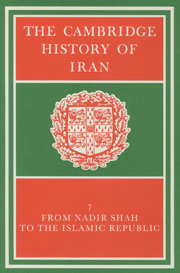Book contents
- Frontmatter
- PART 1 THE POLITICAL FRAMEWORK, 1722–1979
- 1 NĀDIR SHĀH AND THE AFSHARID LEGACY
- 2 THE ZAND DYNASTY
- 3 ĀGHĀ MUHAMMAD KHĀN AND THE ESTABLISHMENT OF THE QĀJĀR DYNASTY
- 4 IRAN DURING THE REIGNS OF FATH ‘Alī SHāH AND MUHAMMAD SHāH
- 5 IRAN UNDER THE LATER QĀJĀRS, 1848–1922
- 6 THE PAHLAVĪ AUTOCRACY: RIŻĀ SHĀH, 1921–41
- 7 THE PAHLAVĪ AUTOCRACY: MUHAMMAD RIŻĀ SHĀH, 1941–1979
- PART 2 FOREIGN RELATIONS
- PART 3 ECONOMIC AND SOCIAL DEVELOPMENTS
- PART 4 RELIGIOUS AND CULTURAL LIFE, 1721–1979
- Genealogical tables
- Bibliographies
- Index
- References
3 - ĀGHĀ MUHAMMAD KHĀN AND THE ESTABLISHMENT OF THE QĀJĀR DYNASTY
from PART 1 - THE POLITICAL FRAMEWORK, 1722–1979
Published online by Cambridge University Press: 28 March 2008
- Frontmatter
- PART 1 THE POLITICAL FRAMEWORK, 1722–1979
- 1 NĀDIR SHĀH AND THE AFSHARID LEGACY
- 2 THE ZAND DYNASTY
- 3 ĀGHĀ MUHAMMAD KHĀN AND THE ESTABLISHMENT OF THE QĀJĀR DYNASTY
- 4 IRAN DURING THE REIGNS OF FATH ‘Alī SHāH AND MUHAMMAD SHāH
- 5 IRAN UNDER THE LATER QĀJĀRS, 1848–1922
- 6 THE PAHLAVĪ AUTOCRACY: RIŻĀ SHĀH, 1921–41
- 7 THE PAHLAVĪ AUTOCRACY: MUHAMMAD RIŻĀ SHĀH, 1941–1979
- PART 2 FOREIGN RELATIONS
- PART 3 ECONOMIC AND SOCIAL DEVELOPMENTS
- PART 4 RELIGIOUS AND CULTURAL LIFE, 1721–1979
- Genealogical tables
- Bibliographies
- Index
- References
Summary
THE EMERGENCE OF THE QĀJĀRS
The preceding chapter described the unsuccessful attempt by a small tribal confederation in south-west Iran, led by the Zands, to establish control over the other tribal groupings on the Iranian plateau. Its failure was due to the limited number of fighting men whom the Zands and their confederates could muster for sustained campaigning; the family rivalries and divisions of the ruling house after Karīm Khān Zand's death in 1193/1779; the superior military resources of the Qājārs; and not least, the single-minded ambition of their ultimate nemesis, Āghā Muhammad Khān Qājār. In this chapter, his career will be placed within the context of the rise of the Qājārs, one of the original components of the Safavids' Qizilbāsh confederacy. For Āghā Muhammad Khān's bid for overall kingship, the disturbed condition of late 18th-century Iran proved particularly favourable.
As for the Qājārs' early history, there is a late tradition that they were part of the Turkish Oghuz confederacy, and first entered Iran with other Oghuz tribes in the 11th century. However, neither of the surviving lists of Oghuz tribes, those of Mahmūd Kashgharī and Rashīd al-Dīn, include them, although both mention the Afshārs. Conceivably, they were an element in a larger tribe (the Bayāts have been suggested as the most likely), from which they later broke away. The same late tradition claims an eponymous ancestor for the tribe in Qājār Noyan, the son of a Mongol, Sartuq Noyan, who was supposed to be Atābeg to the Il-Khān Arghūn. Qājār Noyan was also alleged to be an ancestor of Tīmūr.
- Type
- Chapter
- Information
- The Cambridge History of Iran , pp. 104 - 143Publisher: Cambridge University PressPrint publication year: 1991
References
- 4
- Cited by



